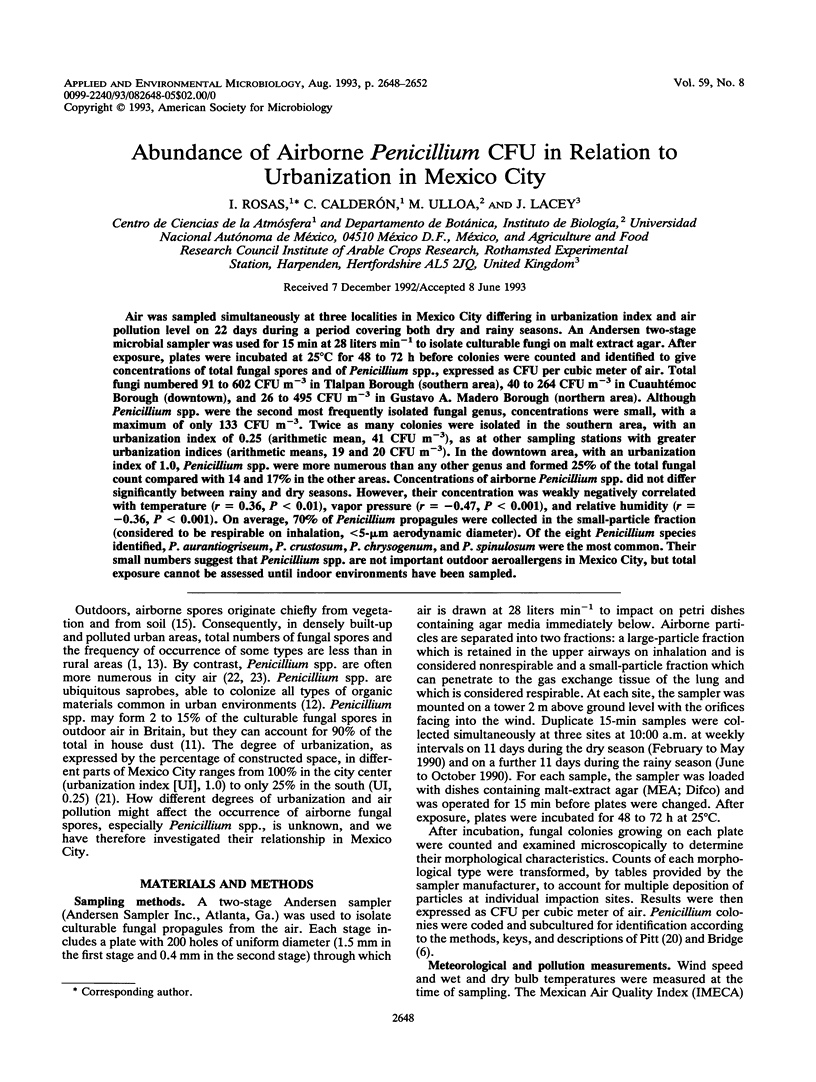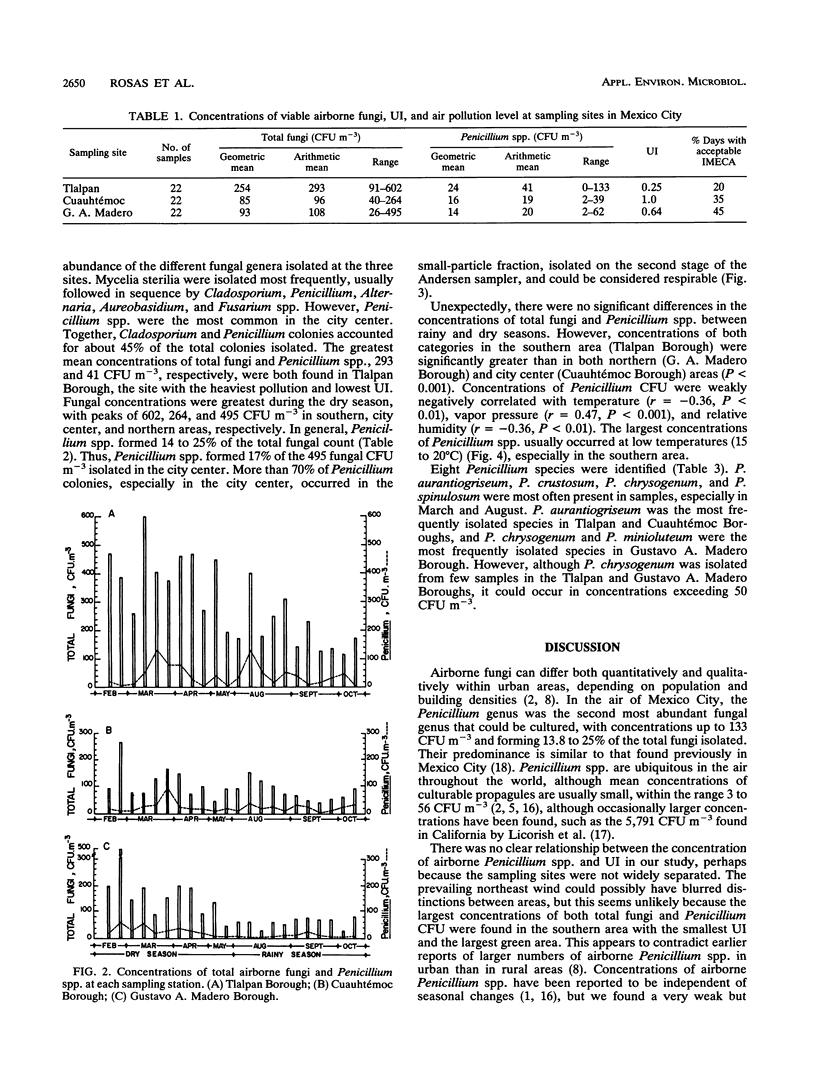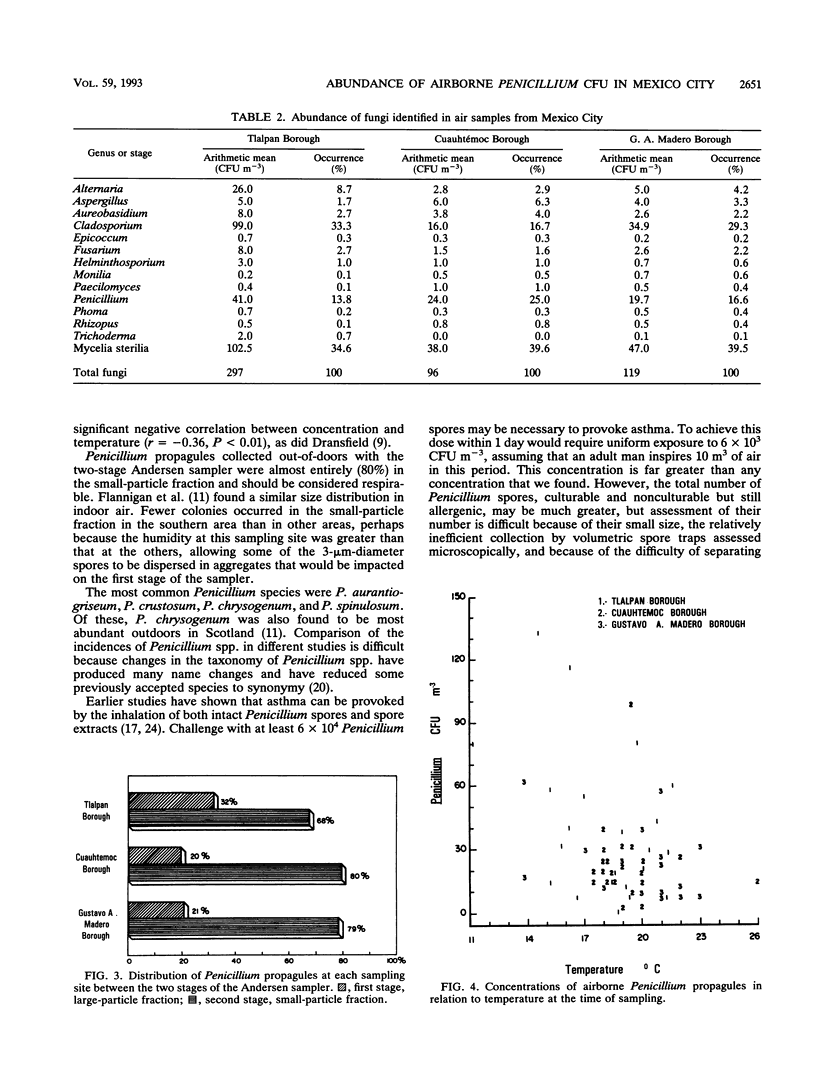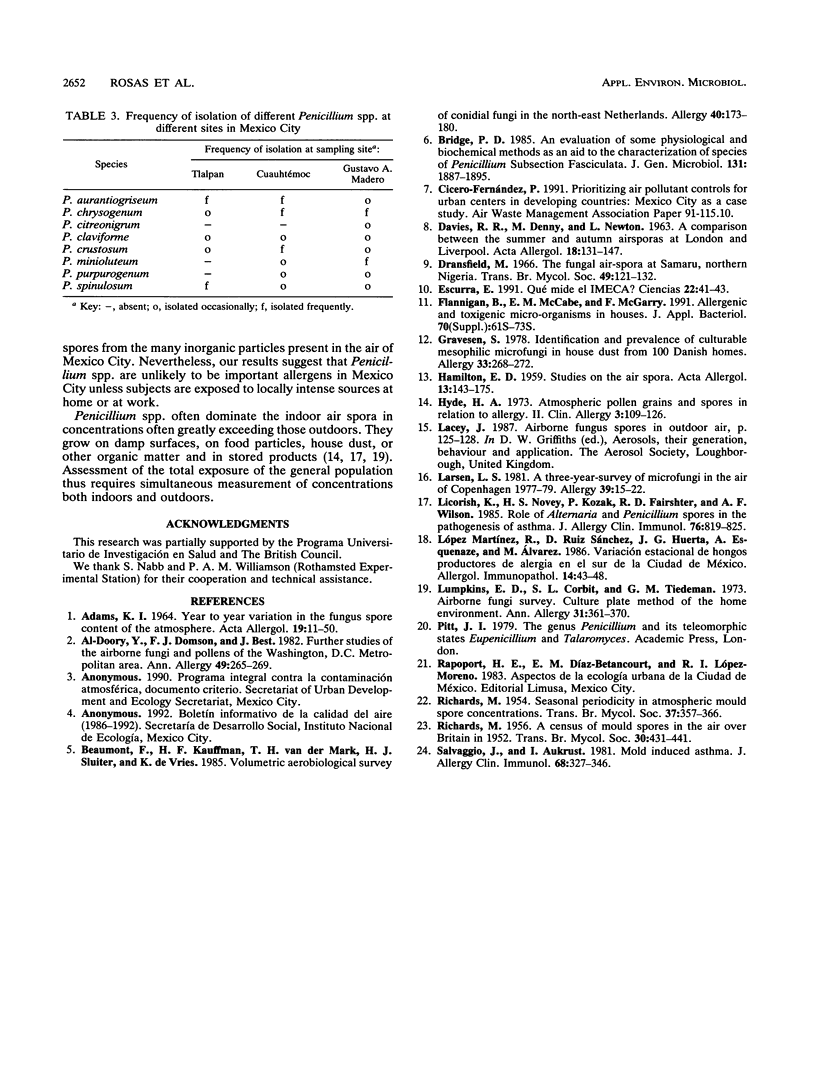Abstract
Air was sampled simultaneously at three localities in Mexico City differing in urbanization index and air pollution level on 22 days during a period covering both dry and rainy seasons. An Andersen two-stage microbial sampler was used for 15 min at 28 liters min-1 to isolate culturable fungi on malt extract agar. After exposure, plates were incubated at 25 degrees C for 48 to 72 h before colonies were counted and identified to give concentrations of total fungal spores and of Penicillium spp., expressed as CFU per cubic meter of air. Total fungi numbered 91 to 602 CFU m-3 in Tlalpan Borough (southern area), 40 to 264 CFU m-3 in Cuauhtémoc Borough (downtown), and 26 to 495 CFU m-3 in Gustavo A. Madero Borough (northern area). Although Penicillium spp. were the second most frequently isolated fungal genus, concentrations were small, with a maximum of only 133 CFU m-3. Twice as many colonies were isolated in the southern area, with an urbanization index of 0.25 (arithmetic mean, 41 CFU m-3), as at other sampling stations with greater urbanization indices (arithmetic means, 19 and 20 CFU m-3). In the downtown area, with an urbanization index of 1.0, Penicillium spp. were more numerous than any other genus and formed 25% of the total fungal count compared with 14 and 17% in the other areas. Concentrations of airborne Penicillium spp. did not differ significantly between rainy and dry seasons.(ABSTRACT TRUNCATED AT 250 WORDS)
Full text
PDF




Selected References
These references are in PubMed. This may not be the complete list of references from this article.
- ADAMS K. F. YEAR TO YEAR VARIATION IN THE FUNGUS SPORE CONTENT OF THE ATMOSPHERE. Acta Allergol. 1964;19:11–50. doi: 10.1111/j.1398-9995.1964.tb03220.x. [DOI] [PubMed] [Google Scholar]
- Al-Doory Y., Domson J. F., Best J. Further studies of the airborne fungi and pollens of the Washington, D.C. metropolitan area. Ann Allergy. 1982 Nov;49(5):265–269. [PubMed] [Google Scholar]
- Beaumont F., Kauffman H. F., van der Mark T. H., Sluiter H. J., de Vries K. Volumetric aerobiological survey of conidial fungi in the North-East Netherlands. I. Seasonal patterns and the influence of metereological variables. Allergy. 1985 Apr;40(3):173–180. doi: 10.1111/j.1398-9995.1985.tb00213.x. [DOI] [PubMed] [Google Scholar]
- DAVIES R. R., DENNY M. J., NEWTON L. M. A COMPARISON BETWEEN THE SUMMER AND AUTUMN AIR-SPORAS AT LONDON AND LIVERPOOL. Acta Allergol. 1963;18:131–147. doi: 10.1111/j.1398-9995.1963.tb03156.x. [DOI] [PubMed] [Google Scholar]
- Flannigan B., McCabe E. M., McGarry F. Allergenic and toxigenic micro-organisms in houses. Soc Appl Bacteriol Symp Ser. 1991;20:61S–73S. [PubMed] [Google Scholar]
- Gravesen S. Identification and prevalence of culturable mesophilic microfungi in house dust from 100 Danish homes. Comparison between airborne and dust-bound fungi. Allergy. 1978 Oct;33(5):268–272. doi: 10.1111/j.1398-9995.1978.tb01547.x. [DOI] [PubMed] [Google Scholar]
- HAMILTON E. D. Studies on the air spora. Acta Allergol. 1959;13(2):143–173. doi: 10.1111/j.1398-9995.1959.tb02761.x. [DOI] [PubMed] [Google Scholar]
- Hyde H. A. Atmospheric pollen grains and spores in relation to allergy. II. Clin Allergy. 1973 Jun;3(2):109–126. doi: 10.1111/j.1365-2222.1973.tb01315.x. [DOI] [PubMed] [Google Scholar]
- Larsen L. S. A three-year-survey of microfungi in the air of Copenhagen 1977-79. Allergy. 1981 Jan;36(1):15–22. doi: 10.1111/j.1398-9995.1981.tb01819.x. [DOI] [PubMed] [Google Scholar]
- Licorish K., Novey H. S., Kozak P., Fairshter R. D., Wilson A. F. Role of Alternaria and Penicillium spores in the pathogenesis of asthma. J Allergy Clin Immunol. 1985 Dec;76(6):819–825. doi: 10.1016/0091-6749(85)90755-9. [DOI] [PubMed] [Google Scholar]
- Lumpkins E. D., Sr, Corbit S. L., Tiedeman G. M. Airborne fungi survey. 1. Culture-plate survey of the home environment. Ann Allergy. 1973 Aug;31(8):361–370. [PubMed] [Google Scholar]
- López Martínez R., Ruiz Sánchez D., Guadalupe Huerta J., Esquenaze A., Alvarez M. T. Variación estacional de hongos productores de alergia en el sur de la ciudad de México. Allergol Immunopathol (Madr) 1986 Jan-Feb;14(1):43–48. [PubMed] [Google Scholar]
- RICHARDS M. Seasonal periodicity in atmospheric mould spore concentrations. Acta Allergol. 1954;7(4):357–366. doi: 10.1111/j.1398-9995.1954.tb03531.x. [DOI] [PubMed] [Google Scholar]
- Salvaggio J., Aukrust L. Postgraduate course presentations. Mold-induced asthma. J Allergy Clin Immunol. 1981 Nov;68(5):327–346. doi: 10.1016/0091-6749(81)90131-7. [DOI] [PubMed] [Google Scholar]


